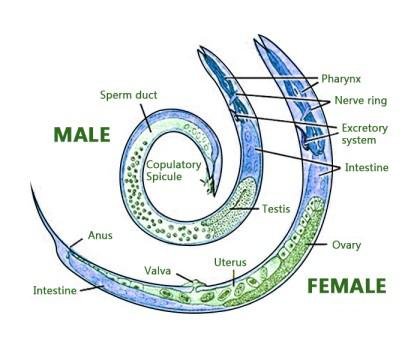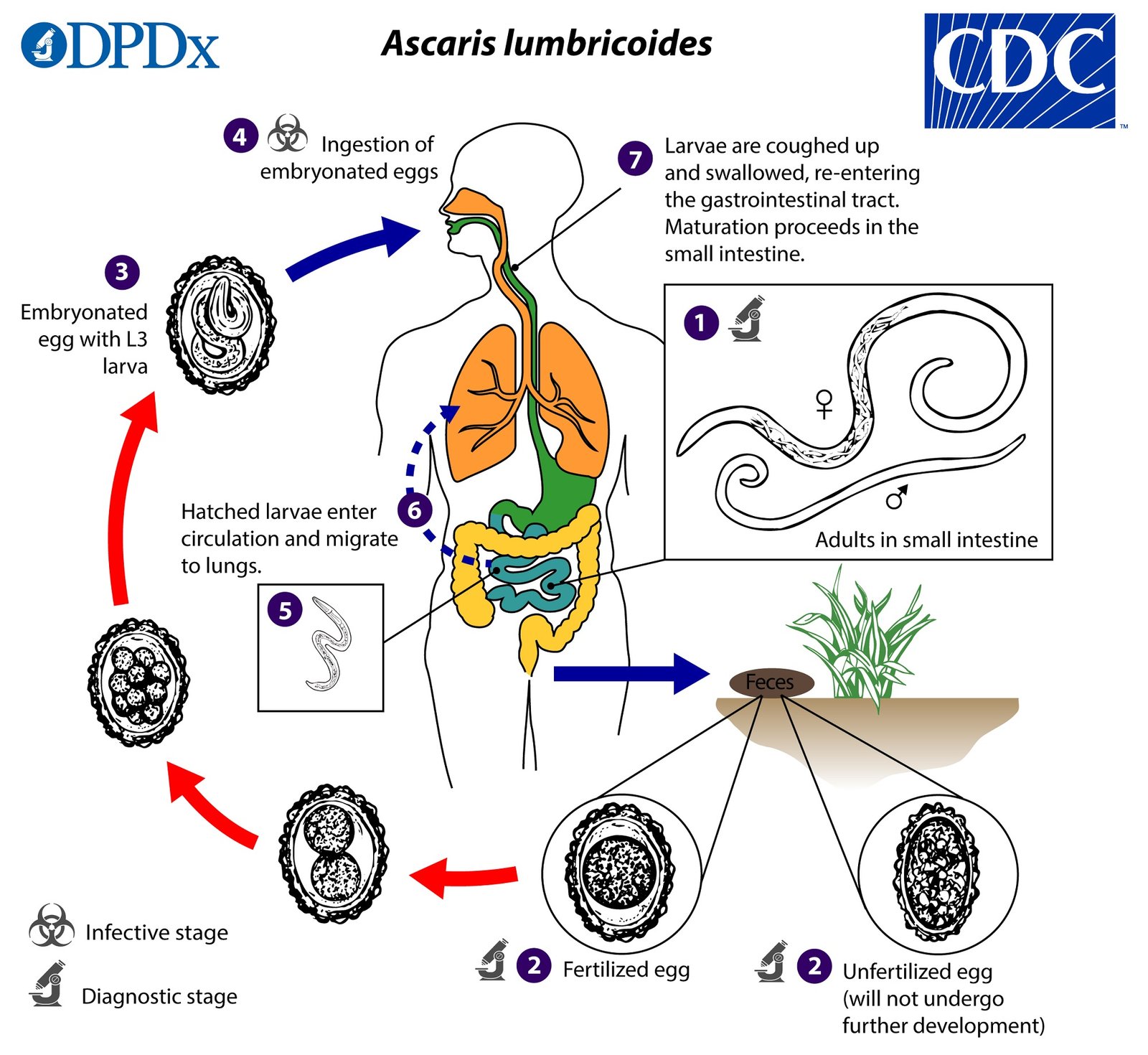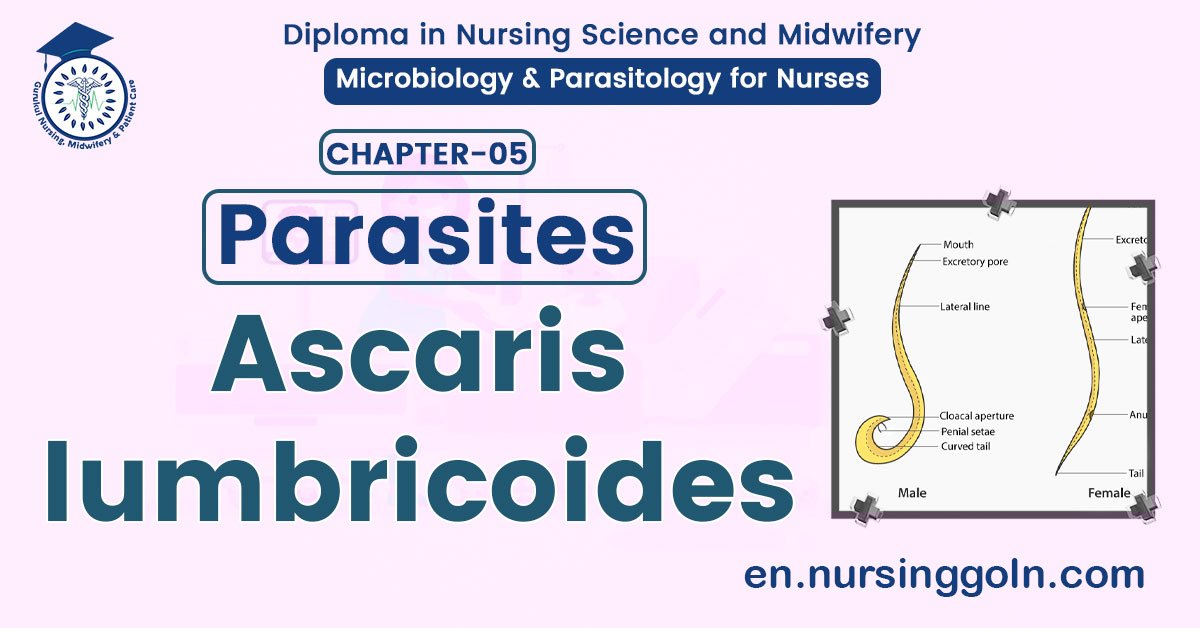Ascaris Lumbricoides – Basic microbiology, parasitology, and immunology; nature, reproduction, growth, and transmission of common microorganisms and parasites in Bangladesh; prevention including universal precaution and immunization, control, sterilization, and disinfection; and specimen collections and examination. Students will have an understanding of common organisms and parasites caused human diseases and acquire knowledge about the prevention and control of those organisms.
Ascaris Lumbricoides
Ascaris lumbricoides is the “large roundworm” of humans, growing to a length of up to 35 cm (14 in). It is one of several species of Ascaris. An ascarid nematode of the phylum Nematoda, it is the most common parasitic worm in humans.

Figure: Ascaris lumbricoides (Male & female).
This organism is responsible for the disease ascariasis, a type of helminthiasis and one of the group of neglected tropical diseases. An estimated one-sixth of the human population is infected by A. lumbricoides or another roundworm.
Ascariasis is prevalent worldwide, especially in tropical and subtropical countries. vd balmes o It has been proposed that Ascaris lumbricoides and Ascaris suum (pig roundworm) are the same species
Life cycle of Ascaris lumbricoides (Round worm):
➤ Infective agent: Embryonated egg.
➤ Infective form: Rhabditiform larva.
➤ Mode of infection: Ingestion of contaminated foods or drinks,
➤ Portal of entry: Alimentary canal (Faeco-oral)
➤ Migration: Through lungs.
➤ Site of location: Small intestine.
➤ Life cycle
- Host- Man is the only known definitive host
- Stages – The various stages in the life cycle are described below :
Stage 1:
Eggs in faeces –
Fertilized eggs containing the unsegmented ovum are passed with the faeces.
↓
Stage 2: Development in soil
A rhabditiform larva is developed from the unsegmented ovum within the egg shell which is infective to host. Before hatching, the larva undergoes a molting.
↓
Stage 3: Infection by ingestion and liberation of larva
When infected with food and drink or raw vegetables, the embryonated eggs pass down to duodenum and rhabditiform larvae are liberated in the upper part of small intestine.
↓
Stage 4: Migration through the lungs
The newly hatched larva burrow this way through the mucous membrane of small intestine and are carried by the portal circulation to the liver -> right heart -> pulmonary circulation → double molting -> lung alveoli.
↓
Stage 5: Re-entry into the stomach and the small intestine
From lung alveoli → Bronchi Trachea→ larynx pharynx swallowed stomach → supper intestine (small)
↓
Stage 6: Sexual maturity and egg liberation
Larva grow into adult worm → Sexually mature → Gravid female → Discharge egg in stool
↓
Cycle is completed and fresh cycle starts

Figure: Life cycle of Ascaris lumbricoides
Pathogenicity/Pathogenic Lesion/Clinical Features:
1. Infection of A. lumbricoides in man is known as Ascariasis.
2. The symptoms due to A. lumbricoides infection may be divided into following three groups –
- Symptoms due to adult worms.
- Symptoms due to eggs.
- Symptoms due to migrating larvae.
They are discussed below:
Symptoms due to adult worms:
➤ Asymptomatic or mild symptoms.
➤ GI tract discomfort: Anorexia, nausea, vomiting.
➤ Spoliative action: Protein-energy malnutrition (PEM) with vitamin A deficiency (Night blindness).
➤ Toxic action: The body fluid of Ascaris when absorbed is toxic and may give rise to typhoid like fever.
➤ Allergic manifestations: Hypersensitivity reaction –> Ascaris encephalopathy.
➤ Mechanical Effect: Intestinal obstruction, intussusception.
➤ Due to migration (Ectopic Ascariasis):
- Suffocation – if ascariasis may accidentally enters into respiratory passage blocks rima glottidis or enters into bronchules.
- Ascaris may come out through mouth and nose.
- Wondering ascariasis: Appendicitis, obstructive jaundice, acute haemorrhagic pancreatitis, liver abscess etc.
Symptoms due to eggs:
➤ Eggs do not cause any lesion in the intestine.
➤ Ova in the biliary canaliculi and liver may produce inflammatory changes.
Symptoms due to migrating larvae:
➤ Bronchitis and pneumonitis
➤ Loeffler’s syndrome
Characteristics of Eggs of Ascaris:
- Characteristics of fertilized egg:
- Round or oval in shape,
- Bile-stained and brownish (golden brown) in colors.
- Surrounded by thick translucent shell with an outer albuminous coat.
- Contains a very large conspicuous, unsegmented ovum.
- Floats in saturated solution of common salt.
Characteristics of unfertilized egg:
- Narrower, longer and more elliptical.
- Brownish in colour (bile-stained)
- Has a thinner shell with an irregular coating of albumin.
- Contains a small atrophied ovum with a mass of disorganized, highly refractile granules of various sizes
- Does not float in salt solution.
Laboratory diagnosis of A. lumbricoides:
- Adult worm: Identification of the adult worms passed through the rectum or from some other body orifice. Abdominal ultrasound may reveals worms in the gastrointestinal or biliary tract
- Eggs: In the stool, vomitus, sputum, or small bowel aspirate,
- Larva: Diagnosis during the stage of larval migration is difficult, although occasionally larvae may be found in the sputum or gastric contents.
- Eosinophil count: An increased number of circulating eosinophil’s may be found during the stage of larval migration.
Complications of Ascaris lumbricoides infection:
Medical condition:
- Ascaris pneumonia (Loeffler’s syndrome).
- Lesions in the various organs like brain, heart and kidney due to larvae in systemic circulation
- Protein-energy malnutrition.
- Night blindness.
- Typhoid like fever due to absorption of toxic body fluid of ascaris lumbricoides.
- Allergic manifestations.
- Inflammatory changes in the liver and biliary canaliculi due to involvement of the ova.
Surgical condition:
- Intestinal obstruction specially in children due to relative small size of the intestinal lumen
- Intussusception
- Ulceration of alimentary canal
- Suffocation
- Appendicitis, obstructive jaundice, acute haemorrhagic pancreatitis due to wondering ascariasis.

Control and prevention:
1. Primary prevention
- Sanitary disposal of faeces
- Provision of safe drinking water
- Food hygiene habits
- Health education of community regarding: Use of sanitary latrines, personal hygiene, and changing behavioural patterns.
2. Secondary prevention:
- Albendazole: 400mg all ages above 2 years, Single dose
- Mebendazole: 500 mg single dose or 100 mg twice daily for 3 days.
- Pyrantel pamoate: 10mg/kg body weight (maximum 1 g) daily for 3 days.
- Levamisole: 50 – 150 mg (3 mg/kg body weight) single dose
- Mass treatment: Periodic deworming at interval of 2 – 3 months may be undertaken in the highly prevalent area. It will reduce worm load of the community

Read More….
